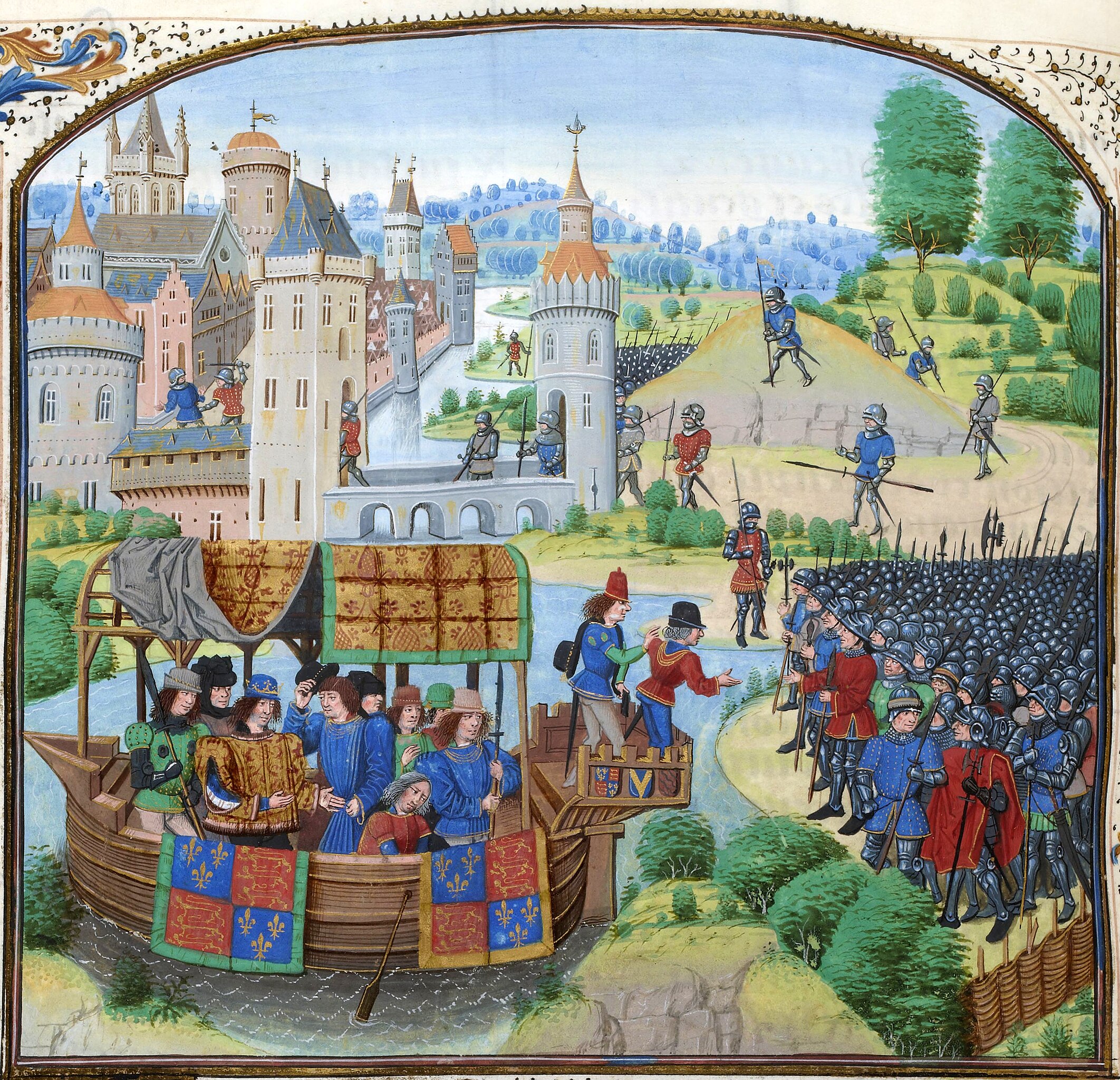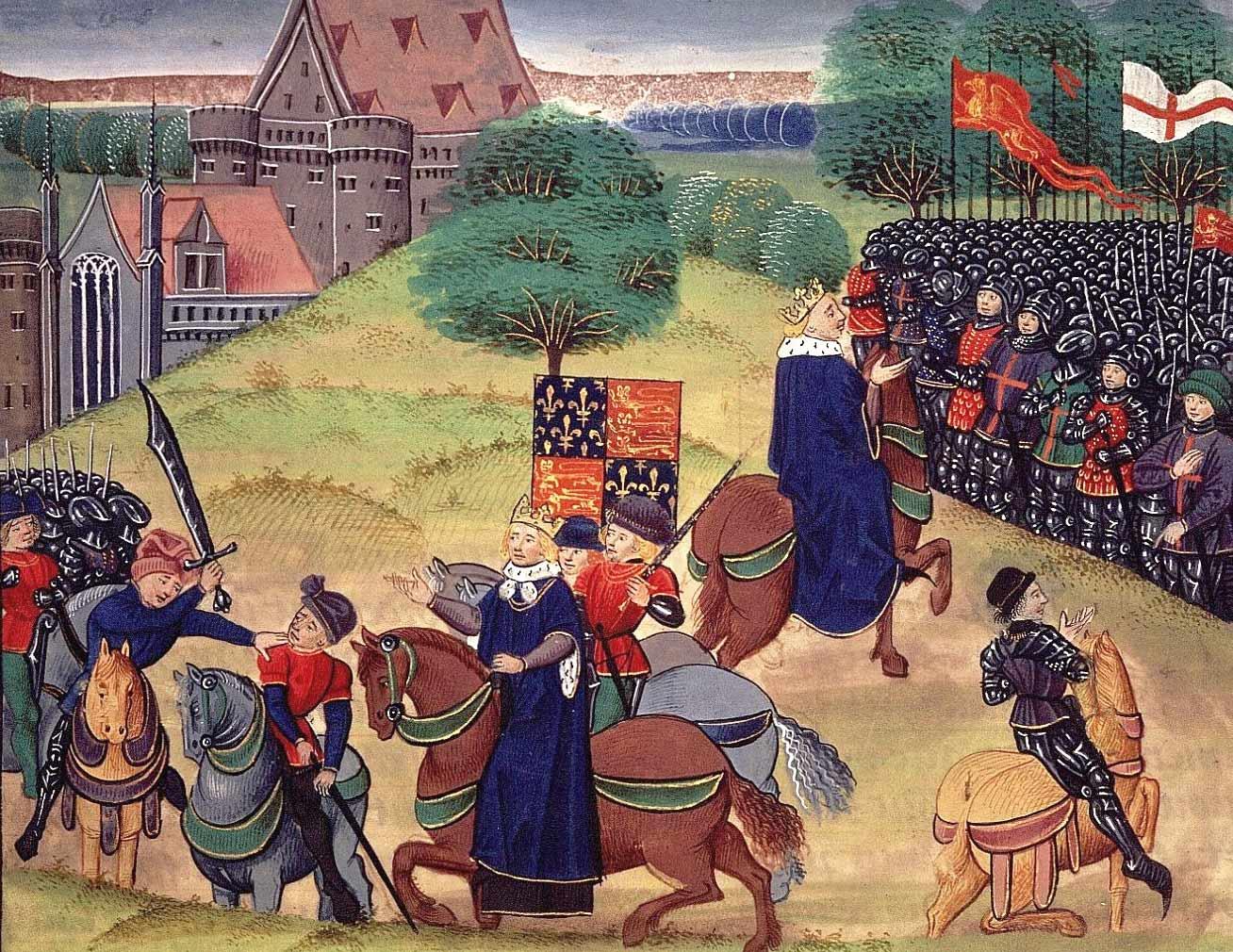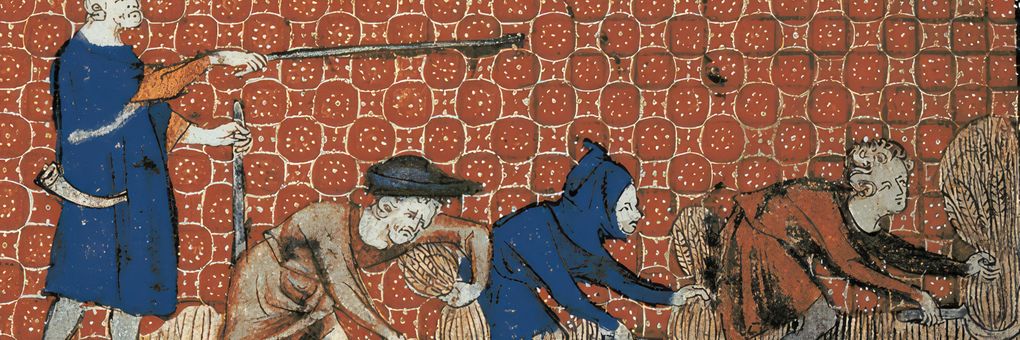Sure, we can complain about our modern work arrangements — noisy open offices, unpaid internships, extra hours, and abusive managers. But thanks to an almost forgotten medieval uprising of serfs, we’ve all benefited from basic economic rights that are now taken for granted. In the late 14th century, Wat Tyler led the English peasantry in a revolt against the harsh work life of the feudal manor. Their battle cry was ending oppressive laws that forced serfs to work for free and extracted from them an endless stream of fees and charges. Tyler’s call for equal treatment for all continues to engage us to this day.
◊
Protests supporting economic equality and civil rights for the disenfranchised spread quickly. Religious leaders take up the cause, and the movement gains sympathizers. Mass protests electrify the nation as marchers stream into cities, gaining new followers with their powerful message. Governments at the local and the national level are surprised and fearful of what might come next as news of property damage and violent encounters reaches the highest levels of leadership.
The U.S. in 2020, or perhaps 1968? Emphatically not. With a little poetic license, I’m instead referring to one of the most overlooked rebellions in Western history. Known as the Great Peasants’ Revolt or Wat Tyler’s Rebellion, it took place over a few weeks in the summer of 1381, involving tens of thousands of English serfs, whose legal status was barely above the level of slaves.
Their goal was an end to English feudalism and its oppressive hierarchical structure: to use force as necessary to gain a commitment from the aristocracy for equal rights, and payment for work under fair contracts. Effectively, the rebels hoped to tear down the foundations of an economic system that had lasted for centuries. It was a system, though, that kept this mostly agrarian population at subsistence levels while a small group of landed aristocrats lived comfortably off the farmers’ toil.
The manor lords ignored their “essential workers” at their own peril. Among the most striking aspects of the Revolt were its suddenness and the organizational abilities of its semi-literate farmers and laborers. Over the course of the rebellion, Wat Tyler, a roof tiler by trade, became a clever military tactician and charismatic political leader. The peasant army was able briefly to paralyze the state before King Richard II’s army ultimately struck back.
Origins of Rebellion: Life on the Manor
The Revolt can be viewed as a long overdue response to the nature of feudal life in England. To be an English serf (or a serf anywhere in Europe) in the late Middle Ages involved carrying out endless obligations on behalf of his aristocratic master, either through payments in kind from his small farm holdings or through direct labor.
Three centuries earlier the Norman conquerors had organized English feudalism, taking land away from the existing Anglo-Saxon lords and dividing it up among the victors. By the time of the rebellion there were several ways to refer to the unfree peasantry: They could be called villeins or serfs (from the Latin servus), bordars (workers with small land holdings), and cotters (day laborers). There were also “free” villeins, but, as we’ll see, even the free were still dependent on the feudal structure.
English village life was centered around the lord’s manor and his own farmland, known as a demesne, a French-Norman word from which “domain” comes. Villeins had their own small land holdings where they grew crops and managed livestock, and for which they paid rent as tenants. But they were also required to work the lord’s demesne. This was unpaid labor and took away from their own heroic efforts to feed themselves.

King Richard II meeting with rebels of the Peasants' Revolt, painting by John Froissart, c. 15th century, collection of Bibliothéque nationale de France (Source: Wikimedia Commons)
While skilled (and free) masons and craftsmen played an important role in the construction of castles and other fortifications, the grunt work of moving and lifting was also done for free, courtesy of the unfree villeins. This forced labor requirement, also known as corveé, was widespread throughout Western Europe, and was a particularly hated aspect of feudalism.
The manor lord continually extracted payments from his serf workforce. In addition to renting a few acres of land, which were divvied out into strips or furloughs, the serf paid a yearly tax or tallage. They also made payments of farm goods to their master during important holidays – say, eggs during Easter and Christmas. Serfs were legally required to use the lord’s mill for grinding grain and baking bread in the lord’s ovens, for which he paid in flour. If the unfree villeins wanted to live or work outside the village, they needed permission – and another tax, known as chevage, had to be given over as well. A more complete list of all the fees and other obligations of the peasantry – it is mind-numbingly long – can be found here.
Better off villeins could avoid feudal labor obligations through cash payments, and ultimately pay their lords to release them from serfdom. The real test of free status, though, was based on whether the villeins had to comply with some of the more intrusive feudal rules. If the villeins didn’t need to seek permission to marry outside their own village, pay the death tax or herriot, and were able to avoid the annual tallage, then they were considered freemen.
The massively unequal relationship between peasant and lord naturally led to minor clashes and sometimes small-scale rebellions. In the 13th century, there were recorded incidents of English peasants refusing to pay the annual tallage, or to perform some of the labor services. Sometimes these protests led to court actions, or petitions directly to the king, but rarely to violence.
The Black Death and Serf Economics
A brief respite from the feudal life came, appallingly, in the form of the bubonic plague, which reached England in 1348. It’s thought that the “Black Death” killed between 30 to 40 percent of the English population. Towns and cities, such as London, saw even higher mortality rates. The Plague returned to England in 1361 and then again sporadically up until the Great Revolt of 1381.
The Plague devastated the English economy. There was a far smaller market for goods, and rents to the lords were greatly reduced. But somewhat counter-intuitively, it raised the incomes of the remaining villeins: With a severe labor shortage, the surviving peasants were able to obtain a premium price for their services. They started calling the shots.
To take back the new economic powers of the peasantry resulting from the Black Death, King Edward III passed a royal ordinance in 1349 to freeze wages at pre-Plague levels. It was widely ignored. The English feudal establishment struck back more definitively with the notorious Statute of Laborers, passed by Parliament in 1351. It was a nationwide law that set wages, limited worker mobility, and also established a strong enforcement mechanism at the local level – serfs could be imprisoned for violating the Statute.
Grievances Lead to Open Revolt
With the death of Edward III, and the ascension of the boy king Richard II to the throne in 1377, the stage was set for the catastrophic uprising.
The long-simmering hostilities between the serfs and their lords came to a boil with the new restrictions on the serfs’ economic power, as spelled out in the Statue of Laborers. Then a series of ill-conceived poll taxes (or head taxes), starting at the end of Edward’s reign and continuing with Richard II, further stoked the anger of the peasantry. The English kings needed to fund their war against the French, and these regressive poll taxes required peasants (men and women) to hand over far more of their wages than they could afford.
In May of 1381, peasants in Essex and Kent began resisting the attempts of the king’s tax collectors. Large gatherings formed, and at this time Wat Tyler emerged as their leader. By early June, the rebels started attacking the properties of the king’s representatives, most significantly the home in Cressing Temple of Sir Robert Hales, the hated royal treasurer.
With the English army away in Scotland, the peasants became emboldened. More villages began to disobey the tax collectors, refusing to pay the poll tax. When the local courts began issuing indictments, the rebels responded violently, killing jurors and destroying buildings representing the court and legal system, along with the records contained inside.
One of Wat Tyler’s demands was the freedom for serfs to sell their crop surplus in the marketplace and directly profit from their work. Under feudal rules, surpluses generally belonged to the manor lord!
The rebels, now an army led by Tyler, swept into the important Kent town of Canterbury, freeing prisoners held in the castle, and burning legal papers in the streets. By this point, King Richard and his advisors back in London had heard news of the rebellion and made initial communication with the rebels.
Tyler’s immediate goal was to end the poll tax. But the destruction of bureaucratic records was meant as a direct blow to the machinery of the feudal bureaucracy. By the second week, the other key rebel leader, the heretical preacher John Ball, emerged. Ball was already known for his radical religious views, and, in his memorable speech at Blackheath addressing the peasant army, he called for an end to all hierarchies – “that the lords be no greater master than we.”
Ball and Tyler led their army to London, where they gained new allies among the urban unskilled and semi-skilled laborers and other wage earners. While in London, their forces pursued lawyers and destroyed more records, burnt Church properties, and beheaded Archbishop Sudbury. The protests were now out of control, but they achieved their goal of frightening Richard. Hiding in the Tower of London, King Richard called for a meeting with Tyler and his followers at Mile End.
The Betrayal at Smithfield
The drama was now close to its final act. At the field of Mile End, Richard and his advisors met Tyler, who delivered his ultimatum: Make all men free forever! Tyler asked for an end to feudal obligations and fees, and particularly for working without pay for the manor lord.
The 14-year old Richard acceded to Tyler’s demands, hoping he’d return to Kent, thereby buying time until his soldiers in Scotland could come back and put down the rebellion. Richard’s gambit failed, however, and Tyler and his rebels continued to destroy properties and behead ministers and merchants. Blood was truly flowing in the streets of London.
Finally, Richard and London’s mayor William Walworth had enough, and set a trap. They agreed to meet Tyler one last time at Smithfield, just outside London’s city walls, on June 15. Asked by Richard for his demands once again, Tyler launched into a meandering vision of a mythical pre-Norman England where everyone was free and equal – when England was truly great.

London Mayor William Walworth attacks rebel leader Wat Tyler at Smithfield.
(Credit: Wat Tyler Country Park)
Tyler took a swig from a jug and spat it out in front of Richard. And that was his last rebellious act. Walworth the London mayor, had concealed a knife in his clothing, and fatally stabbed Tyler. Later that day, Tyler’s head, now on a pike, was paraded around London for all the rebels to see. The peasants’ hopes that King Richard would return England to an imaginary past was completely shattered. The rebellion was essentially over, and the dispirited peasants left London. Richard was victorious.
Wat Tyler’s Revenge
There was still Richard’s retribution, which focused specifically on Essex and Kent counties and the villages where the rebellion started. Hundreds were slaughtered in revenge. For his heresies, John Ball was put on trial, found guilty, and then hanged, beheaded, and disemboweled. In the short term, Wat Tyler’s utopian vision to end feudalism appeared a total failure.
However, never again was there to be a general poll tax. And from that time forward, fearful manor lords granted more economic freedoms to the serfs. Serfdom withered away in England as market forces took hold and lords realized it was more profitable to lease out their desmenes and pay workers to farm their lands.
In the longer run, the peasants with their new freedom of mobility were able to leave the farms and find work in villages and cities, escaping agrarian life but facing new forms of economic feudalism.
Our 21st-century work landscape has certainly changed for the better. But we owe much to Tyler’s vision of fair rules for workers, and his message of equality still echoes down the centuries and continues to drive our politics and reforms.
Ω
Title image: Medieval illustration of men harvesting wheat with reaping-hooks (Public Domain) via Wikimedia Commons.

